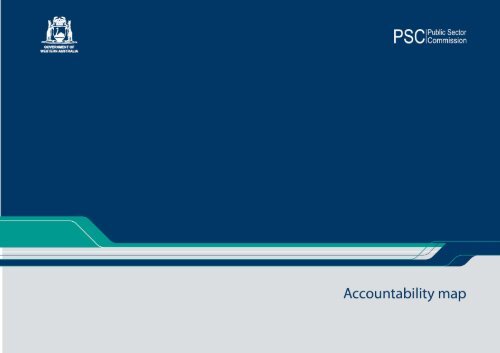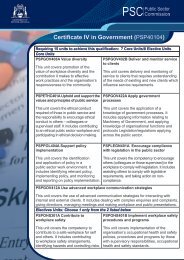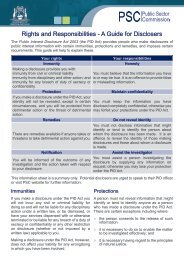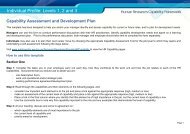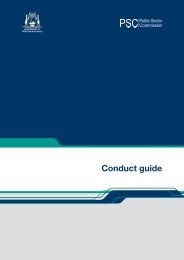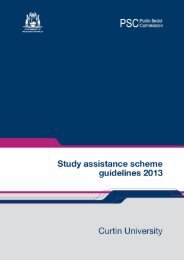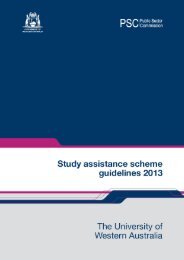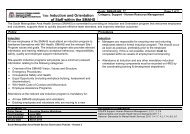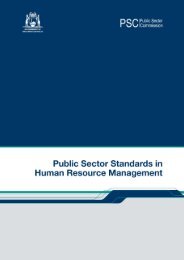Good governance guide accountability map - Public Sector ...
Good governance guide accountability map - Public Sector ...
Good governance guide accountability map - Public Sector ...
You also want an ePaper? Increase the reach of your titles
YUMPU automatically turns print PDFs into web optimized ePapers that Google loves.
Contents<br />
Accountability <strong>map</strong> .......................................................................................................................................................................................................................................................................... 3<br />
Principle 1: Government and public sector relationship .................................................................................................................................................................................................................. 3<br />
Principle 2: Management and oversight .......................................................................................................................................................................................................................................... 4<br />
Principle 3: Organisational structure ............................................................................................................................................................................................................................................... 5<br />
Principle 4: Operations .................................................................................................................................................................................................................................................................... 6<br />
Principle 5 – Ethics and integrity ..................................................................................................................................................................................................................................................... 7<br />
Principle 6 – People ........................................................................................................................................................................................................................................................................ 9<br />
Principle 7 – Finance ..................................................................................................................................................................................................................................................................... 11<br />
Principle 8 – Communication ........................................................................................................................................................................................................................................................ 12<br />
Principle 9 – Risk management .................................................................................................................................................................................................................................................... 13
Accountability <strong>map</strong><br />
The Accountability <strong>map</strong> is a valuable reference for public sector officers with corporate <strong>governance</strong> responsibilities as it provides a list of public sector <strong>accountability</strong> requirements needed to achieve<br />
organisational performance and <strong>accountability</strong>.<br />
The Commission encourages all agencies to use the <strong>map</strong> as a <strong>guide</strong> to ensure that the various agency obligations required under a range of legislation can be readily identified and addressed consistently.<br />
The <strong>map</strong> contains the nine <strong>governance</strong> principles, with operational elements to give effect to each principle. A list of requirements and additional cross-sector resources allows you to navigate through the<br />
<strong>accountability</strong> requirements with a view to simplifying and streamlining your organisation's <strong>governance</strong> framework.<br />
Your organisation may also have systems and processes in place in addition to those described.<br />
Principle 1 – Government and public sector relationship<br />
The organisation's relationship with the government is clear<br />
Principle 1 is unique to the public sector and fundamental to any democratic political system. Ensuring clear and transparent relationships between the elected government and the bureaucracy is critical to<br />
prevent any undue influence in the administration of the public function and to ensure the swift and efficient implementation of government policies and strategies.<br />
Operational element Requirements to achieve organisational performance and <strong>accountability</strong> Additional resources<br />
1.1 A document defines responsibilities and<br />
accountabilities between the chief executive<br />
officer and the minister<br />
1.2 Processes exist to manage<br />
communication and other interaction<br />
between ministers and other parliamentary<br />
representatives and the organisation<br />
1.3 Communication and other interaction are<br />
recorded and monitored<br />
Reporting<br />
• Agency specific legislation<br />
• Financial Management Act 2006 (sections 78 and 79)<br />
• <strong>Public</strong> <strong>Sector</strong> Management Act 1994<br />
• Statutory Corporations (Liability of Directors) Act 1996 (Part 2, Div 3; Part 3 Div 4)<br />
• <strong>Public</strong> <strong>Sector</strong> Management Act 1994 (section 74 and section 105<br />
• Financial Management Act 2006 (sections 81 and 82)<br />
• <strong>Public</strong> <strong>Sector</strong> Commissioner's Circular 2009/10: Communication Agreements Between Ministers and<br />
Agencies<br />
• Administration Instruction 102: Official Communications<br />
• Administrative Instruction 728: Media and <strong>Public</strong> Communications<br />
• <strong>Public</strong> <strong>Sector</strong> Management Act 1994 (section 74)<br />
• <strong>Public</strong> <strong>Sector</strong> Management Act 1994 (section 31)<br />
• State Records Act 2000<br />
• <strong>Public</strong> <strong>Sector</strong> Commissioner's Circular: 2012-01 Annual Reporting<br />
• Annual Reporting Framework
Principle 2 – Management and oversight<br />
The organisation's management and oversight is accountable and has clearly defined responsibilities<br />
Well defined management responsibilities and accountabilities, meaningful strategic plans and work program, as well as independent oversight are cornerstones of <strong>governance</strong> in any type of organisation.<br />
Principle 2 outlines how these concepts should be translated into practice in the unique environment of the public sector.<br />
Operational element Requirements to achieve organisational performance and <strong>accountability</strong> Additional resources<br />
2.1 A charter defines roles, responsibilities<br />
and <strong>accountability</strong> for all relevant levels of<br />
management (e.g. those involved in setting<br />
the organisation’s key strategic goals and<br />
outcomes and monitoring organisational<br />
performance)<br />
2.2 Where boards and committees exist, the<br />
relationship between the parties must be<br />
clearly defined<br />
2.3 A strategic plan outlines the<br />
organisation’s key strategic goals and<br />
outcomes and outputs<br />
2.4 Operational plans and programs of work<br />
exist that define critical success factors and<br />
outline how key strategic goals and<br />
outcomes will be accomplished at all levels<br />
of the organisation<br />
2.5 A delegations framework defines<br />
authority levels<br />
• <strong>Public</strong> <strong>Sector</strong> Management Act 1994 (Part 2)<br />
• Statutory Corporations (Liability of Directors) Act 1996 (Part 2, Divisions 1 and 2, Part 3)<br />
• State Trading Concerns Act 1916<br />
• CEO Performance Agreements<br />
• <strong>Public</strong> <strong>Sector</strong> Management Act 1994 (Sections 3 and 5)<br />
• Treasurer’s Instruction 951: Related and affiliated bodies<br />
• CEO Performance Agreements<br />
• <strong>Public</strong> <strong>Sector</strong> Management Act 1994 (section 29 (1)(a) and (c))<br />
• <strong>Public</strong> <strong>Sector</strong> Management Act 1994 (section 33)<br />
• Financial Management Act 2006<br />
• Treasurer’s Instruction 107: Authorisation<br />
• Standards Australia, AS 8000-2003<br />
Corporate <strong>governance</strong> – <strong>Good</strong><br />
<strong>governance</strong> principles<br />
• ‘Compliance in the public sector’,<br />
Chartered Secretaries Australia<br />
• Standards Australia, HB400 -<br />
Introduction to Corporate<br />
Governance<br />
• <strong>Good</strong> <strong>governance</strong> <strong>guide</strong> for boards<br />
and committees<br />
• Conduct Guide for Boards and<br />
Committees<br />
• <strong>Public</strong> <strong>Sector</strong> Commissioner's<br />
Circular: 2009-22 Strategic Asset<br />
Management Framework<br />
• Standards Australia, AS 8000-2003<br />
Corporate <strong>governance</strong> – <strong>Good</strong><br />
<strong>governance</strong> principles<br />
2.6 Performance measures are defined and<br />
monitored for the organisation’s strategic<br />
goals<br />
• Treasurer’s Instruction 904: Key performance indicators<br />
• CEO Performance Agreements<br />
• Outcome Based Management<br />
Guidelines 2004<br />
(Department of Treasury)
Useful links<br />
• Australian <strong>Public</strong> Service Commission, Foundations of Governance in the Australian <strong>Public</strong> Service (APSC)<br />
• Australian National Audit Office, September 2012, <strong>Public</strong> <strong>Sector</strong> Internal Audit<br />
• Australian National Audit Office, August 2011, <strong>Public</strong> <strong>Sector</strong> Audit Committees<br />
• Australian National Audit Office, August 2003, <strong>Public</strong> <strong>Sector</strong> Governance<br />
• Australian National Audit Office, June 2009, Business Continuity Management: Building Resilience in <strong>Public</strong> <strong>Sector</strong> Entities<br />
Principle 3 – Organisational structure<br />
The organisation’s structure serves its operations<br />
The quality of an organisation's <strong>governance</strong> will depend to a large part on whether its organisational structure is suitable for what the organisation was set up to do. It should reflect the organisation's main<br />
operational objectives and do so in a coherent way while at the same time being flexible enough to respond to changes in the organisation's strategy or mission.<br />
Operational element Requirements to achieve organisational performance and <strong>accountability</strong> Additional resources<br />
3.1 Policies ensure that the organisation’s<br />
structure serves its key strategic goals and<br />
outcomes<br />
3.2 Processes exist to manage structural<br />
change and the relationships between<br />
business units<br />
3.3 Performance measures identify how well<br />
the structure delivers against strategic plans<br />
Reporting<br />
• <strong>Public</strong> <strong>Sector</strong> Management Act 1994 (sections 7(b) to (f), 8 and 29(1)(c) to (f) )<br />
• <strong>Public</strong> <strong>Sector</strong> Management Act 1994 (section 36)<br />
• Financial Management Act (Part 3, Division 4 and 5)<br />
• Treasury Instruction 902: Statement of compliance<br />
• Treasury Instruction 904: Key performance indicators<br />
• CEO Performance Agreements<br />
• <strong>Public</strong> <strong>Sector</strong> Management Act 1994 (section 31)<br />
• Financial Management Act (Part 5, Division 2)<br />
• <strong>Public</strong> <strong>Sector</strong> Commissioner's Circular: 2012-01 Annual Reporting<br />
• Annual Reporting Guidelines
Principle 4 – Operations<br />
The organisation plans its operations to achieve its goals.<br />
Operational planning is a key instrument to ensure <strong>accountability</strong> of an organisation and the effective and efficient management and use of resources. It touches upon numerous aspects of <strong>governance</strong> and<br />
is a key operational tool to increase compliance.<br />
Operational element Requirements to achieve organisational performance and <strong>accountability</strong> Additional resources<br />
4.1 Policies enable operations to deliver<br />
against the organisation’s key strategic goals<br />
and outcomes<br />
Agency specific legislation<br />
• State Supply Commission Act 1991<br />
• State Supply Commission policies<br />
4.2 The organisation’s operational plans and<br />
programs of work support the organisation’s<br />
key strategic goals and outcomes and are<br />
regularly adjusted to changes in strategic<br />
and environmental imperatives<br />
• Outcome Based Management<br />
Guidelines 2004 (Department of<br />
Treasury)<br />
• Project Management Standards<br />
ISO/IEC 17024<br />
4.3 Infrastructure is in place to enable the<br />
organisation to implement its operational<br />
plans<br />
Reporting<br />
• Department of Finance: E-Government and Information Management<br />
• Financial Management Act<br />
• <strong>Public</strong> <strong>Sector</strong> Management Act 1994<br />
• Model Annual Reports<br />
• Annual Reporting Guidelines
Principle 5 – Ethics and integrity<br />
Ethics and integrity are embedded in the organisation's values and operations.<br />
Maintaining a workplace culture with strong ethics and integrity is part of the <strong>governance</strong> framework and is fundamental to good organisational performance. <strong>Public</strong> sector employees must operation with<br />
integrity and maintain high standards of ethical conduct to maintain sound decision making processes and ensure community confidence and trust in the public sector.<br />
Operational element Requirements to achieve organisational performance and <strong>accountability</strong> Additional resources<br />
5.1 The organisation’s values and code of<br />
conduct reflect the WA Code of Ethics and<br />
define the standards of official conduct and<br />
professional behaviour expected of all<br />
employees<br />
5.2 The organisation’s ethics and integrity<br />
risks are identified and policies and<br />
operational processes address them (e.g.<br />
procurement, conflict of interest)<br />
5.3 The people management frameworks<br />
define the response to non-ethical<br />
behaviours<br />
5.4 Processes are in place to provide<br />
supervision and assistance and enable<br />
follow up of non-compliance (e.g. through<br />
public interest disclosure)<br />
• <strong>Public</strong> <strong>Sector</strong> Management Act 1994 (Section 9)<br />
• Commissioner’s Instruction No 7 – Code of Ethics<br />
• Commissioner's Instruction No. 8 – Codes of conduct and integrity training<br />
• Equal Opportunity Act 1984<br />
• Agency’s code of conduct<br />
• Commissioner’s Instruction No 7 – Code of Ethics<br />
• Commissioner's Instruction No. 8 – Codes of conduct and integrity training<br />
• Treasurer’s Instruction 825: Risk management and security<br />
• Equal Opportunity Act 1984 (Parts II to IVB , Section 67 , Part VI and Part VIII Division 2)<br />
• Commissioner’s Instruction No 7 – Code of Ethics<br />
• Agency specific policies<br />
• <strong>Public</strong> <strong>Sector</strong> Management Act 1994<br />
( Part 5 Division 3)<br />
• Corruption and Crime Commission Act 2003<br />
• <strong>Public</strong> Interest Disclosure Act 2003<br />
• <strong>Public</strong> <strong>Sector</strong> Commission<br />
Accountability and Ethical Decision<br />
Making (AEDM) Program<br />
• <strong>Public</strong> <strong>Sector</strong> Commission Conduct<br />
Guide<br />
• Corruption and Crime Commission<br />
Misconduct Resistance Framework<br />
• Government Structures for Better<br />
Results 2001<br />
• AS 8002-2003: Corporate <strong>governance</strong><br />
- Organizational codes of conduct<br />
(external website)<br />
• Australian Standard on Fraud and<br />
Corruption<br />
• Corruption and Crime Commission<br />
Misconduct Resistance Framework<br />
• Integrity Coordinating Group:<br />
Identifying and managing conflicts of<br />
interest in the Western Australian<br />
public sector<br />
• Risk Management Guidelines
Operational element Requirements to achieve organisational performance and <strong>accountability</strong> Additional resources<br />
5.5 A structured process is in place to<br />
monitor official conduct and professional<br />
behaviour (e.g. compliance audit,<br />
performance management)<br />
Reporting<br />
• <strong>Public</strong> <strong>Sector</strong> Commission Disciplinary procedures<br />
• Commissioner’s Instruction No 7 – Code of Ethics<br />
• Financial Management Act 2006 (Part 5 Division 2)<br />
• Corruption and Crime Commission Notification <strong>guide</strong>lines for principal officers of public authorities<br />
• Electoral Act 1907 (s175ZE) expenditure on advertising, market research, polling and direct mail)<br />
• Corruption and Crime Commission Misconduct Resistance Framework<br />
• Commissioners Instruction No 8 – Codes of conduct and integrity training<br />
• Annual Reporting Guidelines<br />
• <strong>Public</strong> Interest Disclosure Act 2003
Principle 6 – People<br />
The organisation's leadership in people management contributes to individual and organisational achievements.<br />
In order to ensure effectiveness and efficiency of its operations, it is important for an organisation to have effective systems for managing its workforce and individual employees. This encompasses fair,<br />
transparent and equal treatment of employees, as well as comprehensive strategies to motivate and lead people and promote personal development.<br />
Operational element Requirements to achieve organisational performance and <strong>accountability</strong> Additional resources<br />
6.1 Policies enable the attraction, retention<br />
and management of people<br />
6.2 Plans ensure that processes, decisions<br />
and actions are based on the principles of<br />
fairness, equity and diversity, and are<br />
consistent, transparent, impartial and open<br />
for review<br />
6.3 People management frameworks cover<br />
the whole employment continuum<br />
• Equal Opportunity Act 1984<br />
• Commissioner's Instruction No.1: Employment Standard<br />
• Commissioner's Instruction No 2: Filling a public sector vacancy<br />
• Agency’s human resource management policies<br />
• <strong>Public</strong> <strong>Sector</strong> Management Act 1994<br />
• Equal Opportunity Act 1984<br />
• Framework for executive classifications<br />
• Industrial Relations Act 1979 (Part II, Divisions 2A and 2B)<br />
• Occupation Safety and Health Act 1984<br />
• Workers' Compensation and Injury Management Act 1981<br />
• <strong>Public</strong> <strong>Sector</strong> Commissioner's Circular: 2012 – 05 Code of Practice - Occupational Safety and Health in<br />
the Western Australian <strong>Public</strong> <strong>Sector</strong><br />
• CEO Performance Agreement<br />
• Equal Opportunity Commission:<br />
Resources for substantive equality<br />
• <strong>Public</strong> <strong>Sector</strong> Commissioner's<br />
Circular: 2011-02 Workforce Planning<br />
and Diversity in the <strong>Public</strong> <strong>Sector</strong><br />
• <strong>Public</strong> <strong>Sector</strong> Commissioner's<br />
Circular: 2009-07 Govt Advertising<br />
and Communications Policy<br />
• Equity and Diversity Workforce<br />
Planning Toolkit<br />
• <strong>Public</strong> <strong>Sector</strong> Commission: Workforce<br />
planning toolkit<br />
• Safety, health and injury management<br />
for the Western Australian<br />
• The policy framework for substantive<br />
equality<br />
• Department of Commerce:<br />
Government Administration<br />
6.4 Structured procedures are in place to<br />
monitor adherence to human resource<br />
policies and processes<br />
• <strong>Public</strong> <strong>Sector</strong> Management Act 1994 (section 9 and 21)<br />
• <strong>Public</strong> <strong>Sector</strong> Management (Breaches of <strong>Public</strong> <strong>Sector</strong> Standards) Regulations 2005<br />
6.5 Feedback processes identify issues in<br />
people management practices<br />
• <strong>Public</strong> <strong>Sector</strong> Commission: Employee perceptions survey<br />
• <strong>Public</strong> sector standards in human resource management – Performance management standard<br />
• Australian <strong>Public</strong> Service Commission:<br />
Sharpening the focus: Managing<br />
performance in the APS
Operational element Requirements to achieve organisational performance and <strong>accountability</strong> Additional resources<br />
Reporting<br />
• Financial Management Act 2006<br />
• <strong>Public</strong> Interest Disclosure Act 2003<br />
• <strong>Public</strong> <strong>Sector</strong> Commissioner's Circular: 2012 – 05 Code of Practice - Occupational Safety and Health in<br />
the Western Australian <strong>Public</strong> <strong>Sector</strong><br />
• Commissioner's Instruction No. 6 – Workforce data reporting obligations<br />
• Annual Reporting Framework
Principle 7 – Finance<br />
The organisation safeguards financial integrity and <strong>accountability</strong>.<br />
Sound financial management is critical to ensure effectiveness in programs and services, <strong>accountability</strong> and efficiency in the management of public resources. It is an essential element to sustain and<br />
improve good <strong>governance</strong>.<br />
Operational element Requirements to achieve organisational performance and <strong>accountability</strong> Additional resources<br />
7.1 Finance policies define the key strategic<br />
goals and outcomes for which the<br />
organisation’s finances must be employed<br />
7.2 A formal internal audit charter specifies<br />
roles and responsibilities, composition and<br />
structure of all internal audit functions<br />
• Constitution Act 1889 (Sections 68 and 72)<br />
• Financial Management Act 2006<br />
• Treasurer’s Instructions<br />
• Financial Management Act 2006 (Part 4 section 53(1)(d))<br />
• Treasurer’s Instruction 1201: Structure of the internal audit function<br />
7.3 Processes ensure the proper recording<br />
of financial transactions consistent with<br />
applicable accounting standards<br />
7.4 Financial operations contribute towards<br />
the organisation’s key strategic goals and<br />
outcomes and uphold the highest level of<br />
integrity<br />
7.5 Structured procedures are in place to<br />
monitor and audit financial performance<br />
against budget and key strategic goals, both<br />
at executive level as well as by an<br />
independent audit committee<br />
• <strong>Public</strong> <strong>Sector</strong> Management Act 1994 (Sections 7(g) and (h), 29(1)(c) and (n) and 30(c))<br />
• Financial Management Act 2006<br />
• Treasurer’s Instructions<br />
• Treasurer’s Instructions (Part IX and XI)<br />
• Financial Management Act 2006 (Part 4 section 53)<br />
• <strong>Public</strong> <strong>Sector</strong> Commissioner's Circular: 2009 -12 Costing and Pricing Government Services<br />
• Treasurer’s Instructions IX, XI, XII<br />
• Financial Administration Bookcase
Principle 8 – Communication<br />
The organisation communicates with all parties in a way that is accessible, open and responsive.<br />
Open, accurate and responsive communication is essential to ensuring an organisation’s <strong>accountability</strong>. <strong>Good</strong> communication is also fundamental to promote citizens' trust in government.<br />
Operational element Requirements to achieve organisational performance and <strong>accountability</strong> Additional resources<br />
8.1 Communication policies ensure the<br />
organisation's communication is open,<br />
accessible and responsive.<br />
8.2 Policies ensure information is<br />
disseminated through correct channels, in a<br />
timely manner and to the right target group<br />
• <strong>Public</strong> <strong>Sector</strong> Management Act 1994 (Section 31)<br />
• Freedom of Information Act 1992 (Section 4; Part 2; Part 3; Part 5)<br />
• <strong>Public</strong> <strong>Sector</strong> Management Act 1994 (Section 74(1))<br />
• State Records Act 2000<br />
• <strong>Public</strong> <strong>Sector</strong> Commissioner's Circular: 2009-07 Govt Advertising and Communications Policy<br />
• <strong>Public</strong> <strong>Sector</strong> Commissioners Circular : 2009-01 Western Australian Language Services Policy 2008<br />
• Premier’s Circular: 2003-17 Requirement for Western Australian Government <strong>Public</strong>ations and Library<br />
Collections<br />
• Administrative Instruction 728: Media and <strong>Public</strong> Communications<br />
• Department of Communities, Office of Multicultural interests, Western Australian Language Services<br />
Policy 2008<br />
• State Records Office: Recordkeeping Plan<br />
• State record keeping, principles, policies and standards<br />
• Ombudsman Western Australia - Record keeping <strong>guide</strong>lines<br />
8.3 Processes ensure proactive, transparent<br />
and responsive internal and external<br />
communication<br />
8.4 Processes assist in complying with<br />
legislation on record keeping, public interest<br />
disclosure and freedom of information, in<br />
safeguarding the confidentiality and integrity<br />
of information, and in preventing<br />
unauthorised, false or premature disclosure<br />
Reporting<br />
• Administrative Instruction 728: Media and <strong>Public</strong> Communications<br />
• Agency’s customer service charter<br />
• <strong>Public</strong> Interest Disclosure Act 2003<br />
• Premier’s Circular: 2003-09 Guidelines for dealing with Cabinet documents under the Freedom of<br />
Information Act 1992<br />
• Administrative Instruction 102: Official Communications<br />
• Administrative Instruction 711: Official Information<br />
• Administrative Instruction 728: Media and <strong>Public</strong> Communications<br />
• Treasurer’s Instruction 502: Records of Attendance and Time Worked<br />
• Treasurer’s Instruction 506: Pay Records State record keeping, principles, policies and standards<br />
• Agency’s complaint resolution policies<br />
• <strong>Public</strong> <strong>Sector</strong> Management Act 1994 (Section 31)<br />
• Financial Management Act 2006<br />
(Part 5, Division 2)<br />
• Annual Reporting Framework<br />
• <strong>Public</strong> <strong>Sector</strong> Commissioner's<br />
Circular: 2010-05 Computer<br />
Information and Internet Security<br />
• State Records Office:<br />
Recordkeeping Plan<br />
• ISO 17799:2005 (Code of Practice<br />
for Information Security<br />
Management)<br />
• AS 4269 – Australian Standard for<br />
Complaints Handling
Useful Links<br />
• Ombudsman Western Australia: Complaints handling <strong>guide</strong>lines<br />
• Ombudsman Western Australia : How to make a complaint<br />
Principle 9 – Risk management<br />
The organisation identifies and manages its risks.<br />
Each organisation has a distinct risk profile. Identifying its particular risk exposure and developing and implementing risk prevention and remediation plans is critical to ensure the organisation can operate<br />
effectively and efficiently to achieve its goals.<br />
Operational element Requirements to achieve organisational performance and <strong>accountability</strong> Additional resources<br />
9.1 Policies exist for the <strong>governance</strong> and<br />
management of material risks (e.g.<br />
reputational, financial or physical, including<br />
occupational safety and health)<br />
9.2 The organisation’s risk exposure is<br />
evaluated and remediation plans are<br />
implemented<br />
• Occupational Health and Safety Act 1984<br />
• Occupational Health and Safety Regulations 1996<br />
• <strong>Public</strong> <strong>Sector</strong> Commissioner's Circular: 2012 – 05 Code of Practice - Occupational Safety and Health in<br />
the Western Australian <strong>Public</strong> <strong>Sector</strong><br />
• <strong>Public</strong> <strong>Sector</strong> Commissioner's Circular: 2009-19 Risk Management and Business Continuity Planning<br />
• Treasurer’s Instruction 825: Risk management and security<br />
• <strong>Public</strong> <strong>Sector</strong> Commissioner's Circular: 2009-19 Risk Management and Business Continuity Planning<br />
• Treasurer’s Instruction 812: Insurance<br />
• Treasurer’s Instruction 825: Risk management and security<br />
• Safework Australia<br />
• RiskCover – Risk Management<br />
Guidelines<br />
• WorkSafe<br />
• Guidance note: Formal consultative<br />
processes at the workplace<br />
• Standards Australia - AS/NZS ISO<br />
31000:2009 Risk management -<br />
Principles and <strong>guide</strong>lines<br />
• Standards Australia - HB 436:2004<br />
Risk management <strong>guide</strong>lines<br />
companion<br />
• Standards Australia - Delivering<br />
assurance based on ISO<br />
31000:2009 Risk Management<br />
• Safework Australia<br />
• RiskCover – Risk Management<br />
Guidelines<br />
• WorkSafe<br />
• Guidance note: Formal consultative<br />
processes at the workplace<br />
• Standards Australia - AS/NZS ISO<br />
31000:2009 Risk management -<br />
Principles and <strong>guide</strong>lines<br />
• Standards Australia - HB 436:2004<br />
Risk management <strong>guide</strong>lines<br />
companion<br />
• Standards Australia - Delivering
9.3 Preventive measures for key risk<br />
categories are in place<br />
• <strong>Public</strong> <strong>Sector</strong> Commissioner's Circular: 2009-19 Risk Management and Business Continuity Planning<br />
• Treasurer’s Instruction 825: Risk management and security<br />
assurance based on ISO<br />
31000:2009 Risk Management<br />
• RiskCover – Risk Management<br />
Guidelines<br />
9.4 Procedures are in place to monitor<br />
incidents from the identified risk categories<br />
(data analysis)<br />
• <strong>Public</strong> <strong>Sector</strong> Commissioner's Circular: 2009-19 Risk Management and Business Continuity Planning<br />
• Treasurer’s Instruction 825: Risk management and security<br />
• RiskCover – Risk Management<br />
Guidelines<br />
• Standards Australia - AS/NZS ISO<br />
31000:2009 Risk management -<br />
Principles and <strong>guide</strong>lines<br />
• Standards Australia - HB 436:2004<br />
Risk management <strong>guide</strong>lines<br />
companion<br />
• Standards Australia - Delivering<br />
assurance based on ISO<br />
31000:2009 Risk Management


